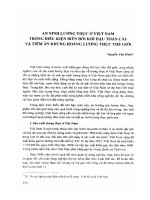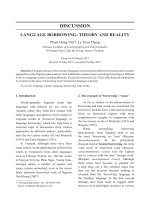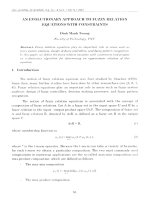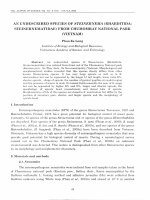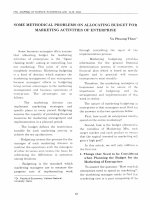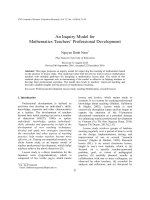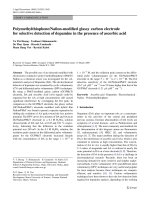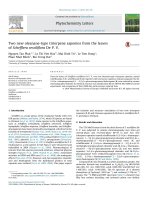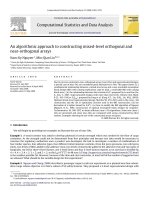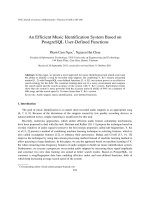DSpace at VNU: An extremely efficient and green method for the acylation of secondary alcohols, phenols and naphthols with a deep eutectic solvent as the catalyst
Bạn đang xem bản rút gọn của tài liệu. Xem và tải ngay bản đầy đủ của tài liệu tại đây (718.66 KB, 6 trang )
View Article Online
View Journal
RSC Advances
This article can be cited before page numbers have been issued, to do this please use: P. H. tran and H.
T. Nguyen, RSC Adv., 2016, DOI: 10.1039/C6RA22757K.
This is an Accepted Manuscript, which has been through the
Royal Society of Chemistry peer review process and has been
accepted for publication.
Accepted Manuscripts are published online shortly after
acceptance, before technical editing, formatting and proof reading.
Using this free service, authors can make their results available
to the community, in citable form, before we publish the edited
article. This Accepted Manuscript will be replaced by the edited,
formatted and paginated article as soon as this is available.
You can find more information about Accepted Manuscripts in the
Information for Authors.
Please note that technical editing may introduce minor changes
to the text and/or graphics, which may alter content. The journal’s
standard Terms & Conditions and the Ethical guidelines still
apply. In no event shall the Royal Society of Chemistry be held
responsible for any errors or omissions in this Accepted Manuscript
or any consequences arising from the use of any information it
contains.
www.rsc.org/advances
PleaseRSC
do not
adjust margins
Advances
Page 1 of 5
View Article Online
DOI: 10.1039/C6RA22757K
Journal Name
Received 00th January 20xx,
Accepted 00th January 20xx
DOI: 10.1039/x0xx00000x
An extremely efficient and green method for the acylation of
secondary alcohols, phenols and naphthols with deep eutectic
solvent as catalyst
Hai Truong Nguyen and Phuong Hoang Tran*
www.rsc.org/
The typical deep eutectic solvent [CholineCl][ZnCl2]3 easily prepared
from choline chloride and zinc chloride is green and useful for the
acylation of secondary alcohols, phenols, and naphthols with acid
anhydrides. Its efficiency allows the acylation of sterically hindered
secondary alcohols and acid anhydrides to proceed in high yield
under mild condition. The catalyst is cheap, easy to handle,
conveniently synthesized in a single step, and recyclable for several
times without significant loss of the catalytic activity.
The acylation of alcohols with acid anhydrides is a valuable
tool in the synthesis of biologically active compounds and
1-3
pharmaceutical products.
This reaction is commonly
catalysed by acid or base catalysts which are only efficient for
4-6
highly reactive primary alcohols. Although there have been
7-10
advances in acylation methods,
highly efficient, low-cost
and green catalysts are still in strong demand for the acylation
of sterically-hindered secondary alcohols and phenols. Up to
now, 4-(dimethylamino)pyridine (DMAP) has been the most
widely used nucleophile base catalyst for the acylation of
sterically-hindered alcohols even though it is known to have
acute toxicity.11 Other catalysts that have been shown to be
efficient for acylation of sterically-hindered alcohols are metal
triflates, such as scandium triflate,12 trimethylsilyl triflate,13
indium triflate,14 bismuth triflate.15 Amongst these, scandium
triflate and bismuth triflate demonstrated highly catalytic
activity. However, these catalysts required the use of donor
solvents such as dichloromethane, THF, or acetonitrile and the
excess of acid anhydrides (3-5 equiv.). Furthermore, despite
being classified as strong, efficient and stable Lewis acidic
catalysts, metal triflates are expensive, and the recycling of
catalyst involving the recrystallization from the toxic organic
solvent such as acetonitrile is required. Consequently, they are
not convenient to apply on a large scale. Bartoli and coworkers reported the use of Mg(ClO4)2 and Zn(ClO4)2.6H2O as
the better alternatives to metal triflates. This research showed
that the Zn(ClO4)2.6H2O is able to act as a powerful catalyst
16
which can be potentially applied in industrial processes.
However, this catalyst cannot be recovered and reused after
the aqueous work-up. Recently, Li and co-workers developed
DMAP saccharin-catalysed acylation of alcohols with an almost
equimolar amount of anhydrides under solvent-free and base17
free conditions. More recently, Collado and co-workers
reported the uses of titanium(III) species as a reductant for O18
acylation of alcohols and phenol. Although these methods
are efficient, many of them involve high-cost catalyst, large
amounts of volatile organic solvents and/or long reaction
times.
The development of green and sustainable chemistry has led
to the search for an efficient and environmentally benign
catalyst.19 The deep eutectic solvents which are composed of
two or three components to form an eutectic mixture with
lower melting point than individual components were first
prepared by Abbott’s group in 2001.20 Up to now, they have
been used as catalysts for many organic transformations
including C-C, C-O, C-N bonding formation.21-25 Deep eutectic
solvents possessing the excellent catalytic activity and stability
can be comfortably handle due to low toxic, non-corrosive
properties. Moreover, these catalyst are easily recovered and
reused without the significant loss of reactivity.26
Consequently, deep eutectic solvents are suitable for industrial
applications.27-32
In our previous work, we found the Friedel–Crafts acylation of
aromatic compounds proceeded smoothly in the presence of
[CholineCl][ZnCl2]3 as dual solvent–catalyst.25 Herein, we
report that [CholineCl][ZnCl2]3 demonstrates efficient catalytic
activity for the acylation of sterically-hindered secondary
alcohols and phenols under mild condition. Until now, its use
as a catalyst for acylation of alcohols and phenols has
remained unreported. The Lewis acidity of [CholineCl][ZnCl2]3 is
J. Name., 2013, 00, 1-3 | 1
This journal is © The Royal Society of Chemistry 20xx
Please do not adjust margins
RSC Advances Accepted Manuscript
Published on 11 October 2016. Downloaded by Cornell University Library on 12/10/2016 17:40:00.
COMMUNICATION
PleaseRSC
do not
adjust margins
Advances
Page 2 of 5
View Article Online
DOI: 10.1039/C6RA22757K
COMMUNICATION
Journal Name
The results listed in Table 1 demonstrate the powerfully catalytic
activity of [CholineCl][ZnCl2]3 in the propionylation of 1phenyletanol at room temperature for 30 min under solvent-free
condition. The reactions were carried out with propionic anhydride
(1.05 equiv.) in the presence of 35 mol% of the catalyst. The
propionylation of sterically-hindered 1-phenyletanol did not
proceed in the presence of traditional Brønsted acid (Table 1, entry
2). Bismuth triflate was not reactive under the present method
(Table 1, entry 3). As previously reported, bismuth triflate-catalyzed
acylation of 1-phenyletanol proceeded quantitatively but required
the excess of acylating reagent (10 equiv) and took a longer
reaction time (2 h).15 The excellent yield was noted under catalytic
influence of [CholineCl][ZnCl2]3 (Table 1, entry 10). The reaction was
also carried out on a 10 mmol scale, and the yield is almost the
same as on 1 mmol scale (94% vs 96%, entry 10). The control
experiments were investigated by employing individual
components such as choline chloride (entry 4) or ZnCl2 (entry 5).
ZnCl2 displayed good catalytic activity but it cannot be recovered
after aqueous workup. The search for other deep eutectic solvents
was conducted but the lower yields of products (Table 1, entries 69) were noted in comparison with [CholineCl][ZnCl2]3.
Table 1 The solvent-free propionylation of 1-phenyletanol with
propionic anhydride at room temperature.
a
Entry
Catalyst
Yield (%)
1
None
0
2
H2SO4
0
b
3
Bi(OTf)3
7
4
Choline chloride
6
5
ZnCl2
80
6
[CholineCl][urea]2
0
7
[CholineCl][Malonic acid]
7
8
[CholineCl][Oxalic acid]
38
9
[Urea]7[ZnCl2 ]2
5
c
10
[CholineCl][ZnCl2]3
96 (94)
a
b
c
Isolated yield. 10 mol% of Bi(OTf)3 was used. 10
mmol scale reaction.
Under the optimal condition, the scope of acylating reagents was
investigated by treating 1-phenyletanol with acetic, butyric and
benzoic anhydride in the presence of 35 mol% of
[CholineCl][ZnCl2]3. The desired products were obtained in good to
excellent yields at room temperature for 30 min (Table 2, entries 13). The benzoic anhydride afforded the lowest yield due to its least
reactivity (Table 2, entry 4). The benzoylation of 1-phenyletanol
taken place for 30 min afforded only 55% yield while prolonging the
reaction time to 180 min produced 80% yield under the present
method. As previously reported, the acylation of alcohols
proceeded with complete retention of configuration at the
10, 13, 15, 18
hydroxyl-bearing carbon.
Table 2 The solvent-free acylation of 1-phenyletanol with acid
anhydrides at room temperature.
Entry
Acid anhydride
Yielda (%)
1
Acetic anhydride
81
2
Propionic anhydride
96
3
Butyric anhydride
86
4
Benzoic anhydride
55
a
Isolated yield
After these preliminary results, the propionylation of secondary
alcohols and phenols was conducted in the presence of 35 mol% of
[CholineCl][ZnCl2]3 at room temperature (Table 3). The aliphatic
acyclic secondary alcohols containing 3–7 carbon atoms,
cyclohexanol, and menthol were propionylated in excellent yields,
and no olefin was detected (Table 3, entries 1-7). The
propionylation
of
isoborneol
[CholineCl][ZnCl2]3-catalysed
proceeded smoothly at room temperature for only 30 min under
solvent-free (Table 3, entry 8). The use of bismuth triflate, in this
case, was reported with co-solvent (THF or toluene) and with longer
33
reaction time (3 h to 7 h). In addition, no side-product was
detected under the present method. Moreover, it is noteworthy
that the desired products obtained after the workup attained the
sufficient purity for NMR analysis without further purification.
Remarkably, the propionylation of diphenylmethanol bearing more
sterically hindered substituents afforded the desired benzhydryl
propionate in 83% yield along with 17% yield of dibenzhydryl ether
as a side product (Table 3, entry 10). In the previous report, only
34
moderate yield was obtained for the same reaction. Per-Oacylation is one of the most useful techniques for the protection of
35
hydroxyl groups in carbohydrates. In the current method, per-Opropionylation of α-D-glucose with the stoichiometric quantity
of propionic anhydride afforded in excellent yield (Table 3,
entry 11). As previously reported, a similar yield was obtained
in the presence of pyridine derivative and excess of acylating
17
reagent or organic solvent. Myo-inositol and phosphorylated
myo-inositol derivatives are useful precursors which play an
important role in calcium mobilization, insulin stimulation,
36
exocytosis,
cytoskeletal
regulation.
Myo-inositol
was
propionylated in 95% isolated yield of the per-O-propionylated
product at room temperature for 120 min. Phenols and naphthols
were also reactive under the current method (Table 3, entries 1315). Tertiary alcohols were unreactive under any investigated
conditions (Table 3, entries 16, 17). As reported by Procopiou, no
acetylation of tertiary alcohols by acetic anhydride was observed in
the presence of TMSOTf as a catalyst. The reaction only proceeded
in a slow rate with the addition of DMAP.13 It has also been known
that 1,1-diphenyletanol was not acetylated by acetic anhydride in
the presence of Zn(ClO4)2.6H2O.16
2 | J. Name., 2012, 00, 1-3
This journal is © The Royal Society of Chemistry 20xx
Please do not adjust margins
RSC Advances Accepted Manuscript
Published on 11 October 2016. Downloaded by Cornell University Library on 12/10/2016 17:40:00.
robust enough to promote the acylation of sterically-hindered
secondary alcohols to afford the acylated products in quantitative
yields. Moreover, [CholineCl][ZnCl2]3 is easily prepared, stable to air
and moisture, low-cost, and recyclable without loss of catalytic
activity.
PleaseRSC
do not
adjust margins
Advances
Page 3 of 5
View Article Online
DOI: 10.1039/C6RA22757K
Journal Name
COMMUNICATION
Published on 11 October 2016. Downloaded by Cornell University Library on 12/10/2016 17:40:00.
Entry
Substrate
Time
(min)
30
35
30
40
40
45
30
30
60
60
100
120
60
100
110
150
150
Yielda
(%)
88
89
91
89
94
92
89
93
96
b
83
c
94
d
95
95
90
92
e
trace
e
trace
1
Propan-2-ol
2
Butan-2-ol
3
Pentan-2-ol
4
Hexan-2-ol
5
Heptan-2-ol
6
Cyclohexanol
7
Menthol
8
Isoborneol
9
1-Phenyletanol
10
Diphenylmetanol
11
α-D-Glucose
12
myo-Inositol
13
4-Methoxyphenol
14
[1,1’-Biphenyl]-2-ol
15
2-Naphthol
16
2-Phenylpropan-2-ol
17
1,1-Diphenylethanol
a
Isolated yield.
b
Side product is (oxybis(methanetriyl))tetrabenzene.
c
per-O-propionylated in the presence of a stoichiometric
quantity of propionic anhydride (5 mmol).
d
per-O-propionylated in the presence of a stoichiometric
quantity of propionic anhydride (6 mmol).
e
The major alkene products were obtained by the
dehydration of tertiary alcohols.
The recycling ability of [CholineCl][ZnCl2]3 was investigated under
optimized condition by using 1-phenyletanol as substrate (Scheme
37
1). After completion of the reaction, the crude product was
extracted with diethyl ether. The recovered [CholineCl][ZnCl2]3 was
dried under reduced pressure in 6 h and reused without further
purification. The [CholineCl][ZnCl2]3 could be successfully reused
four times without significant loss of catalytic activity.
93
90
89
88
Run 1
Run 2
Run 3
Run 4
Scheme 1 Recycling ability of [CholineCl][ZnCl2]3 in the
propionylation of 1-phenyletanol. Conditions: 1-phenyletanol
(1.00
mmol),
propionic
anhydride
(1.05
mmol),
[CholineCl][ZnCl2]3 (0.35 mmol) at room temperature for 30 min.
Yields are isolated yields after aqueous workup.
In conclusion, we have developed [CholineCl][ZnCl2]3 as a
recyclable and highly efficient catalyst for the acylation of stericallyhindered alcohols and phenols. This is the first time that the
acylation of secondary alcohols and phenols using deep
eutectic solvent as a catalyst has been reported. Moreover, the
present method demonstrates several merits, including a cheap and
highly stable catalyst, mild reaction conditions, operational
simplicity and no need for volatile organic solvents or inert
atmosphere condition. The fact that [CholineCl][ZnCl2]3 can be
easily prepared from commercially available cheap reactants makes
it more favorable than formerly investigated catalysts for acylation
of alcohols such as DMAP or metal triflates (2–10 mol%) even
though an uncommon large catalytic quantity of DES (35 mol%) was
required for a complete conversion. Besides, the high efficiency of
[CholineCl][ZnCl2]3 allows for the acylation of poorly reactive
secondary alcohols under milder condition. Even a challenging
substrate for acylation as diphenylmethanol can be also
propionylated in good yield at room temperature. Moreover,
the [CholineCl][ZnCl2]3 is efficient, easily recovered and reused
without significant loss of catalytic activity for four consecutive
cycles, making it ideal for industrial processes.
Acknowledgements
This research is funded by Vietnam National University-Ho Chi
Minh City (VNU – HCM) under grant number C2016-18-21. We
thank Duy-Khiem Nguyen Chau (University of Minnesota –
Duluth, USA) and Ngoc-Mai Hoang Do (IPH-HCM, Vietnam) for
their helps.
Notes and references
1. H. K. Moon, G. H. Sung, B. R. Kim, J. K. Park, Y.-J. Yoon and H.
J. Yoon, Adv. Synth. Catal., 2016, 358, 1725-1730.
2. F. Pollastro, S. Golin, G. Chianese, M. Y. Putra, A. Schiano
Moriello, L. De Petrocellis, V. Garcia, E. Munoz, O. TaglialatelaScafati and G. Appendino, J. Nat. Prod., 2016, 79, 1762-1768.
3. Z. Liu, Q. Ma, Y. Liu and Q. Wang, Org. Lett., 2014, 16, 236239.
4. M. Nahmany and A. Melman, Org. Biomol. Chem., 2004, 2,
1563-1572.
5. A. K. Chakraborti and R. Gulhane, Chem. Commun., 2003,
1896-1897.
6. M. Jager and A. J. Minnaard, Chem. Commun. (Camb), 2016,
52, 656-664.
7. G. Sartori, R. Ballini, F. Bigi, G. Bosica, R. Maggi and P. Righi,
Chem. Rev., 2004, 104, 199-250.
8. B. Borgstrom, X. Huang, M. Posta, C. Hegardt, S. Oredsson
and D. Strand, Chem. Commun. (Camb), 2013, 49, 9944-9946.
9. J. Gonzalez-Sabin, R. Moran-Ramallal and F. Rebolledo,
Chem. Soc. Rev., 2011, 40, 5321-5335.
10. S. A. Forsyth, D. R. MacFarlane, R. J. Thomson and M. von
Itzstein, Chem. Commun., 2002, 714-715.
J. Name., 2013, 00, 1-3 | 3
This journal is © The Royal Society of Chemistry 20xx
Please do not adjust margins
RSC Advances Accepted Manuscript
Table 3 The solvent-free propionylation of secondary alcohols
and phenols at room temperature.
PleaseRSC
do not
adjust margins
Advances
Page 4 of 5
View Article Online
DOI: 10.1039/C6RA22757K
Journal Name
11. A. Sakakura, K. Kawajiri, T. Ohkubo, Y. Kosugi and K. Ishihara,
J. Am. Chem. Soc., 2007, 129, 14775-14779.
12. A. G. M. Barrett and D. Christopher Braddock, Chem.
Commun., 1997, 351-352.
13. P. A. Procopiou, S. P. D. Baugh, S. S. Flack and G. G. A. Inglis,
J. Org. Chem., 1998, 63, 2342-2347.
14. N. P. Bizier, S. R. Atkins, L. C. Helland, S. F. Colvin, J. R.
Twitchell and M. J. Cloninger, Carbohydr. Res., 2008, 343, 18141818.
15. A. Orita, C. Tanahashi, A. Kakuda and J. Otera, J. Org. Chem.,
2001, 66, 8926-8934.
16. G. Bartoli, M. Bosco, R. Dalpozzo, E. Marcantoni, M.
Massaccesi and L. Sambri, Eur. J. Org. Chem., 2003, 2003, 46114617.
17. N. Lu, W. H. Chang, W. H. Tu and C. K. Li, Chem. Commun.
(Camb), 2011, 47, 7227-7229.
18. M. J. Durán-Peña, J. M. Botubol-Ares, J. R. Hanson, R.
Hernández-Galán and I. G. Collado, Eur. J. Org. Chem., 2016,
2016, 3584-3591.
19. E. L. Smith, A. P. Abbott and K. S. Ryder, Chem. Rev., 2014,
114, 11060-11082.
20. A. P. Abbott, G. Capper, D. L. Davies, H. L. Munro, R. K.
Rasheed and V. Tambyrajah, Chem. Commun., 2001, 2010-2011.
21. Q. Zhang, K. De Oliveira Vigier, S. Royer and F. Jerome, Chem.
Soc. Rev., 2012, 41, 7108-7146.
22. P. Liu, J.-W. Hao, L.-P. Mo and Z.-H. Zhang, RSC Adv., 2015, 5,
48675-48704.
23. H.-C. Hu, Y.-H. Liu, B.-L. Li, Z.-S. Cui and Z.-H. Zhang, RSC Adv.,
2015, 5, 7720-7728.
24. J. Cao, B. Qi, J. Liu, Y. Shang, H. Liu, W. Wang, J. Lv, Z. Chen,
H. Zhang and X. Zhou, RSC Adv., 2016, 6, 21612-21616.
25. P. H. Tran, H. T. Nguyen, P. E. Hansen and T. N. Le, RSC Adv.,
2016, 6, 37031-37038.
26. D. Z. Troter, Z. B. Todorović, D. R. Đokić-Stojanović, O. S.
Stamenković and V. B. Veljković, Renew. Sustainable Energy
Rev., 2016, 61, 473-500.
27. G. García, S. Aparicio, R. Ullah and M. Atilhan, Energy Fuels,
2015, 29, 2616-2644.
28. J. I. García, H. García-Marín and E. Pires, Green Chem., 2014,
16, 1007-1033.
29. J. Yin, J. Wang, Z. Li, D. Li, G. Yang, Y. Cui, A. Wang and C. Li,
Green Chem., 2015, 17, 4552-4559.
30. J. Patiño, M. C. Gutiérrez, D. Carriazo, C. O. Ania, J. B. Parra,
M. L. Ferrer and F. d. Monte, Energy Environ. Sci., 2012, 5, 86998707.
31. C. Mukesh, R. Gupta, D. N. Srivastava, S. K. Nataraj and K.
Prasad, RSC Adv., 2016, 6, 28586-28592.
32. R. Wahlstrom, J. Hiltunen, M. Pitaluga de Souza Nascente
Sirkka, S. Vuoti and K. Kruus, RSC Adv., 2016, 6, 68100-68110.
33. A. Orita, C. Tanahashi, A. Kakuda and J. Otera, Angew. Chem.
Int. Ed., 2000, 39, 2877–2879.
34. L. Zhang, Y. Luo, R. Fan and J. Wu, Green Chem., 2007, 9,
1022-1025.
35. A. K. Misra, P. Tiwari and S. K. Madhusudan, Carbohydr. Res.,
2005, 340, 325-329.
36. K. M. Sureshan, M. S. Shashidhar, T. Praveen and T. Das,
Chem. Rev., 2003, 103, 4477-4504.
37. General procedure: 1-Phenyletanol (122 mg, 1.0 mmol) was
treated with propionic anhydride (136 mg,1.05 mmol) in the
presence of [CholineCl][ZnCl2]3 (191 mg, 0.35 mmol) for 30 min
at room temperature under solvent-free magnetic stirring. The
mixture was diluted with diethyl ether (10 x 5 ml). The ether
solution was decanted, washed with H2O (10 mL), aqueous
NaHCO3 (2 x 20 mL), and brine (10 mL), and dried over MgSO4.
The solvent was removed on a rotary evaporator to afford the
desired product (432 mg, 96%). The product was characterized
1
13
by H and C NMR, and MS. The recovered catalyst was
o
activated by heating under reduced vacuum at 80 C for 6 h and
reused for consecutive cycles.
4 | J. Name., 2012, 00, 1-3
RSC Advances Accepted Manuscript
Published on 11 October 2016. Downloaded by Cornell University Library on 12/10/2016 17:40:00.
COMMUNICATION
This journal is © The Royal Society of Chemistry 20xx
Please do not adjust margins
Page 5 of 5
RSC Advances
View Article Online
DOI: 10.1039/C6RA22757K
RSC Advances Accepted Manuscript
Published on 11 October 2016. Downloaded by Cornell University Library on 12/10/2016 17:40:00.
An efficient and green method was developed for the acylation of secondary alcohols, phenols and
naphthols using deep eutectic solvent [CholineCl][ZnCl2]3 as a catalyst at room temperature under
solvent-free condition.
